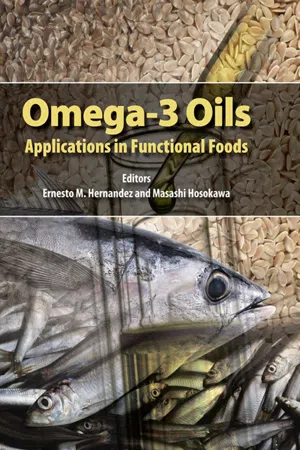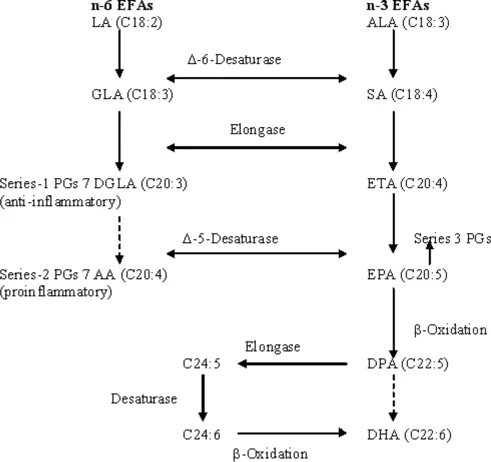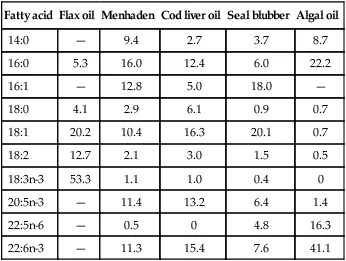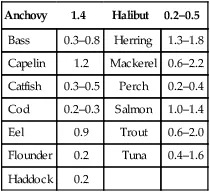
eBook - ePub
Omega-3 Oils
Applications in Functional Foods
Ernesto Hernandez,Masashi Hosokawa
This is a test
- 312 Seiten
- English
- ePUB (handyfreundlich)
- Über iOS und Android verfügbar
eBook - ePub
Omega-3 Oils
Applications in Functional Foods
Ernesto Hernandez,Masashi Hosokawa
Angaben zum Buch
Buchvorschau
Inhaltsverzeichnis
Quellenangaben
Über dieses Buch
This book addresses new applications of omega-3 fatty acids from both plant and marine sources in food supplements and pharmaceuticals and covers three basic areas: structure and function, production and processing, and health effects. The authors review the latest clinical evidence on the impact of consumption of omega-3 polyunsaturated fatty acids on prevalent human diseases such as inflammation-related illnesses in general and cardiovascular illnesses in particular. They also examine technologies to purify marine oils and protect them against oxidation as well as novel techniques for their incorporation into foods.
- Covers the role omega-3 plays in general health and disease and includes several reviews on the latest clinical evidence
- Explains different methods to deliver omega-3 to the consumer, through various methods including food fortification, nutritional supplements, and more
- Considerations for the processing of omega-3 oils to minimize conditions that could destroy the nutrtional properties.
Häufig gestellte Fragen
Wie kann ich mein Abo kündigen?
Gehe einfach zum Kontobereich in den Einstellungen und klicke auf „Abo kündigen“ – ganz einfach. Nachdem du gekündigt hast, bleibt deine Mitgliedschaft für den verbleibenden Abozeitraum, den du bereits bezahlt hast, aktiv. Mehr Informationen hier.
(Wie) Kann ich Bücher herunterladen?
Derzeit stehen all unsere auf Mobilgeräte reagierenden ePub-Bücher zum Download über die App zur Verfügung. Die meisten unserer PDFs stehen ebenfalls zum Download bereit; wir arbeiten daran, auch die übrigen PDFs zum Download anzubieten, bei denen dies aktuell noch nicht möglich ist. Weitere Informationen hier.
Welcher Unterschied besteht bei den Preisen zwischen den Aboplänen?
Mit beiden Aboplänen erhältst du vollen Zugang zur Bibliothek und allen Funktionen von Perlego. Die einzigen Unterschiede bestehen im Preis und dem Abozeitraum: Mit dem Jahresabo sparst du auf 12 Monate gerechnet im Vergleich zum Monatsabo rund 30 %.
Was ist Perlego?
Wir sind ein Online-Abodienst für Lehrbücher, bei dem du für weniger als den Preis eines einzelnen Buches pro Monat Zugang zu einer ganzen Online-Bibliothek erhältst. Mit über 1 Million Büchern zu über 1.000 verschiedenen Themen haben wir bestimmt alles, was du brauchst! Weitere Informationen hier.
Unterstützt Perlego Text-zu-Sprache?
Achte auf das Symbol zum Vorlesen in deinem nächsten Buch, um zu sehen, ob du es dir auch anhören kannst. Bei diesem Tool wird dir Text laut vorgelesen, wobei der Text beim Vorlesen auch grafisch hervorgehoben wird. Du kannst das Vorlesen jederzeit anhalten, beschleunigen und verlangsamen. Weitere Informationen hier.
Ist Omega-3 Oils als Online-PDF/ePub verfügbar?
Ja, du hast Zugang zu Omega-3 Oils von Ernesto Hernandez,Masashi Hosokawa im PDF- und/oder ePub-Format sowie zu anderen beliebten Büchern aus Sciences physiques & Chimie industrielle et technique. Aus unserem Katalog stehen dir über 1 Million Bücher zur Verfügung.
Information
1
Omega-3 Fatty Acids in Health and Disease
Fereidoon Shahidi, Department of Biochemistry, Memorial University of Newfoundland, St. John’s, Newfoundland, Canada
Introduction
The omega-3 (n-3) fatty acids belong to the family of polyunsaturated fatty acids (PUFAs) with three or more double bonds with the first unsaturation site occurring on the third carbon from the methyl end group. The location of the first unsaturation site dictates the biological activity of the molecules involved. Other double bonds are positioned in a methylene-interrupted manner with respect to the first and subsequent double bonds. Omega-6 fatty acids constitute another family of PUFAs; the first member of this family is linoleic acid (LA, 18:2n-6).
The first member of the omega-3 family and the parent molecule in this series is alpha-linolenic acid (ALA, 18:3n-3), which is abundant in flaxseed oil and is also present in canola, soybean, and walnut oils, among other commodities. Meanwhile, stearidonic acid (18:4n-3) has been detected in viable amounts in several species of algae, fungi, and animal tissues, as well as seeds of Echium (Boraginaceae). It has also been produced in soybean transgenitically. The other important omega-3 fatty acids, namely eicosapentaenoic acid (EPA, 20:5n-3), docosahexaneoic acid (DHA, 22:6n-3), and to a lesser extent, docosapentaenoic acid (DPA, 22:5n-3), are found in high amounts in certain algal species and in marine oils, primarily those from the body of fatty fish species such as herring and mackerel, the liver of lean white fish such as cod and halibut, and the blubber of marine mammals such as whales and seals. These important all cis omega-3 oils may also be recovered from processing by-products of wild catch and aquaculture fisheries (Shahidi, 2007; Zhong et al., 2007). While alpha-linolenic acid may be metabolized in the body via a series of desaturation and elongation reactions (Fig. 1.1), the production of long-chain omega-3 PUFA from ALA is limited and may vary from 1 to 5% (Shahidi & Finley, 2001). This is because conversion of ALA to stearidonic acid (SA, 18:4n-3) via the action of DELTA-6 desaturase is the slowest and thus the rate-determining step. This enzyme may be impaired and its activity reduced owing to aging, disease condition, lifestyle factors, micronutrient deficiency, or to use of certain drugs. Thus, adequate dietary intake of long-chain PUFA is generally recommended to maintain health and reduce disease risk. The fatty acid composition of selected plant, algal, and animal sources of omega-3 fatty acids are summarized in Table 1.A.
Table 1.A
Fatty Acid Composition of Omega-3 Oils.a
| Fatty acid | Flax oil | Menhaden | Cod liver oil | Seal blubber | Algal oil |
| 14:0 | — | 9.4 | 2.7 | 3.7 | 8.7 |
| 16:0 | 5.3 | 16.0 | 12.4 | 6.0 | 22.2 |
| 16:1 | — | 12.8 | 5.0 | 18.0 | — |
| 18:0 | 4.1 | 2.9 | 6.1 | 0.9 | 0.7 |
| 18:1 | 20.2 | 10.4 | 16.3 | 20.1 | 0.7 |
| 18:2 | 12.7 | 2.1 | 3.0 | 1.5 | 0.5 |
| 18:3n-3 | 53.3 | 1.1 | 1.0 | 0.4 | 0 |
| 20:5n-3 | — | 11.4 | 13.2 | 6.4 | 1.4 |
| 22:5n-6 | — | 0.5 | 0 | 4.8 | 16.3 |
| 22:6n-3 | — | 11.3 | 15.4 | 7.6 | 41.1 |
aSeal blubber oil contains 12.2% of 20:1 and 2.0% of 22:1.

Omega-3 Fatty Acids in Food and Daily Intake Requirements
As it was noted, plant sources of omega-3 oils provide ALA, which may promote health. However, the importance of omega-3 fatty acids is often ascribed to the long-chain PUFAs, especially EPA and DHA. The total content of EPA and DHA in various fish varies and depends on the type of fish and their habitat. The proportion of omega-3 fatty acids in fish muscle is higher in fatty fish such as herring, mackerel, and salmon than in lean fish such as cod, flounder, haddock, perch, and halibut (Table 1.B). Meanwhile, shellfish such as crab (0.3%–0.4%), shrimp (0.2%–0.5%), and lobster (0.3%–0.4%) have low levels of omega-3 fatty acids, and mollusks may also contain low levels of omega-3 fatty acids (e.g., squid, scallops, oysters, and mussels, 0.2%–0.6%) or no omega-3 fatty acids (abalone and some species of clam) (Shahidi, 2006; 2007; Barrow & Shahidi, 2008).
Table 1.B
Content (g/100g) of Omega-3 Fatty Acids (EPA + DHA)a in Selected Fish.
| Anchovy | 1.4 | Halibut | 0.2–0.5 |
| Bass | 0.3–0.8 | Herring | 1.3–1.8 |
| Capelin | 1.2 | Mackerel | 0.6–2.2 |
| Catfish | 0.3–0.5 | Perch | 0.2–0.4 |
| Cod | 0.2–0.3 | Salmon | 1.0–1.4 |
| Eel | 0.9 | Trout | 0.6–2.0 |
| Flounder | 0.2 | Tuna | 0.4–1.6 |
| Haddock | 0.2 |
aEPA, eicosapentaenoic acid; DHA, docosahexaenoic acid.
The total recommended daily intake of EPA and DHA is age-dependent. It should be up to 1.5 g for children 1–8 years old, 2.0 g for 9–13 years old, and 2.5 g for 14–18 years old; this value may reach up to 3.0 g/day for adults, depending on the purpose and type of studies conducted. Owing to the oxidizability of such oils, their supplementation with antioxidants such as vitamin E is recommended. However, most suppliers of fish oil capsules generally add vitamin E to their products in order to arrest oxidative processes; this would also address the increasing need of the body on antioxidants because of consumption of highly unsaturated lipids which would otherwise cause oxidative stress. Although manufacturers as well as consumers of dietary supplements may use alpha-tocopherol, mainly d-alpha-tocopherol, manufacturers of omega-3 capsules often use mixed tocopherols from soybean oil-refining deodorizer-distillate, which is rich in gamma-tocopherol, as a source of vitamin E for stabilizing the oil because gamma-tocopherol is a much more effective antioxidant than alpha-tocopherol in vitro and hence it better protects the oil from oxidative deterioration.
In order to take advantage of omega-3 fatty acids, there has been a surge in the retail market in the appearance of fortified foods as well as a myriad of dietary supplements containing omega-3 fatty acids—occasionally ALA, but mainly EPA and DHA (Shahidi, 2006). Although use of such oils has traditionally been restricted owing to their instability and flavor reversion, availability of stabilized products such as microencapsulated and coacervated marine oils have allowed manufacturers to offer a variety of products. These include cereal-based products such as crackers, bars, bread, and pasta; dairy-based products such as milk, yogurt, and specialty dairy-based drinks; and juices, such as orange juice, as well as other commodities. Table 1.C summarizes the types of products in which omega-3 oils may be used for fortification and/or enrichment purposes. In addition, candies, pastries, and other confectionary products containing omega-3 fatty acids have appeared. Furthermore, meat products and even seafoods have been fortified in test markets and in product development. These formulated commodities either use microencapsulated and coacervated marine oils and do not release their content until it reaches the gastrointestinal tract or employ stabilized omega-3 oils by using sophisticated refining techniques and powerful antioxidants.
Table 1.C
Different Classes of Food Products Enriched with Omega-3 Fatty Acids.
| Class | Items |
| Dairy | Milk, yogurt, yogurt-based drinks |
| Grain-based | Bread, cereals, pasta, bars |
| Confectionary | Sweets, candies, bars |
| Spreads | Margarine, butter, spreads |
| Dressings | Salad dressing, mayonnaise, etc. |
| Juices | Orange juice, other fruit juices, etc. |
| Muscle foods | Meat, fish, and poultry products |
| Infant foods | Formula, etc. |
| Eggs | Hen eggs and products thereof |
| Others | Specialty products |
For therapeutic purposes, concentrates of omega-3 fatty acids—for example, up to 75% omega-3 content, or even capsules containing pure omega-3 fatty acids—may be used for certain health conditions. The concentrates may be in the ethyl ester form or as triacylglycerols, reconstituted to appear as natural or true-to-nature. Commercially available concentrates may contain equal amounts of EPA and DHA, or predominantly EPA or DHA, depending on the end use. Procedures used for concentration of omega-3 fatty acids are varied and are beyond the mandate of this brief overview (Shahidi & Wanasundara, 1998).
Omega-3 Fatty Acids in Health and Disease
Marine oils and their omega-3 fatty acids provide the best example of functional food ingredients and nutraceuticals that may serve as a continuum for their perceived and demonstrated health benefits. Thus, they may prevent ailments caused by their deficiency, such as those encountered in the body, and secondly they aid in reducing disease risk, and thirdly they act as therapeutic agents in treating certain diseases or conditions.
A large body of literature provides information about the health benefits of omega-3 fatty acids, mainly those arising from EPA and DHA. EPA and DHA serve as building blocks of cells in vital organs, particularly those with electrical activity such as the brain, the heart, and the eye, and also are important for normal growth and development (Shahidi & Miraliakbari, 2004; 2005). Therefore, adequate intake of omega-3 fatty acids by pregnant and lactating women is encouraged in order to addr...

